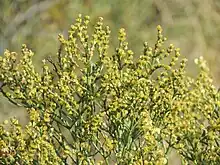Anabasis aphylla
Anabasis aphylla is a species of flowering plant in the family Amaranthaceae, native to the region surrounding the Caspian Sea, Central Asia, and Xinjiang and western Gansu provinces of China.[1] A many-branched shrub usually found growing in alluvial fans and dune swales, it is sometimes planted to catch blowing soil and stabilize sand dunes.[2] The alkaloid anabasine was named for this toxic species, from which it was first isolated by Orechoff and Menschikoff in the year 1931. Anabasine was widely used as an insecticide in the former Soviet Union until 1970.[3]
| Anabasis aphylla | |
|---|---|
 | |
| Scientific classification | |
| Kingdom: | Plantae |
| Clade: | Tracheophytes |
| Clade: | Angiosperms |
| Clade: | Eudicots |
| Order: | Caryophyllales |
| Family: | Amaranthaceae |
| Genus: | Anabasis |
| Species: | A. aphylla |
| Binomial name | |
| Anabasis aphylla | |
| Synonyms[1] | |
| |
References
- "Anabasis aphylla L." Plants of the World Online. Royal Botanic Gardens, Kew. Retrieved 9 February 2022.
- Fern, Ken (30 July 2021). "Useful Temperate Plants Anabasis aphylla". temperate.theferns.info. Temperate Plants Database. Retrieved 9 February 2022.
- Ujváry, István, Pest Control Agents from Natural Products - Chapter 3 of Hayes' Handbook of Pesticide Toxicology (Third Edition), ed. Robert Krieger, pub. Academic Press 2010.
This article is issued from Wikipedia. The text is licensed under Creative Commons - Attribution - Sharealike. Additional terms may apply for the media files.